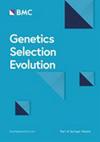通过分离 GWAS 对具有不完全渗透性的非加性基因座进行线性化:以绵羊的角状况为例
IF 3.1
1区 农林科学
Q1 AGRICULTURE, DAIRY & ANIMAL SCIENCE
引用次数: 0
摘要
本研究的目的是将全基因组关联研究(GWAS)与单基因分类性状的分离分析相结合。根据表型、遗传方式和血统信息计算出的基因型概率用预期等位基因数(EAC)表示(范围在 0 到 2 之间),根据定义,EAC 是加性遗传,这与原始表型不同,原始表型是非加性遗传,可能具有不完全渗透性。EAC对单核苷酸多态性(SNP)基因型进行回归,类似于加性 GWAS。在本研究中,我们利用美利奴羊的角表型来说明使用分离 GWAS 的优势,这种性状被认为是单基因性的,受显性遗传的影响,其表达依赖于性别,并可能受不完全渗透性的影响。我们还利用模拟研究了不完全渗透是否会导致美利奴羊角状况的预测错误。不同性别之间的估计穿透力值存在差异,雄性的穿透力几乎是完全的,尤其是在有角和有花粉的表型上,而雌性在有角的表型上穿透力值较低。这表明,等位基因 "有角 "的雌性只有 22% 的情况下会出现有角的表型,而 78% 的情况下会出现有节或有鳞。与使用实际表型相比,使用 4001 只动物的 EAC 和来自 Illumina Ovine 高密度(600k)芯片的 510,174 个 SNP 基因型进行的 GWAS 发现了更强的关联性。EAC与-log10(p值)最高的SNP等位基因数之间的相关性在雄性动物中为0.73,在雌性动物中为0.67。使用分离分析发现的渗透率值进行模拟,EAC 与致病突变之间的相关性更高(男性分别为 0.95,女性为 0.89),这表明最具预测性的 SNP 与致病突变不存在完全 LD。我们的研究结果表明,雄性美利奴羊和雌性美利奴羊的角状况渗透值存在明显差异。对具有互斥表型、非加性遗传和/或不完全穿透性的性状进行分离分析,可以大大提高 GWAS 的效率,因为线性化的基因型概率是加性的,而且可以适应不完全穿透性。这种方法可扩展到表型相互排斥的任何单基因受控分类性状。本文章由计算机程序翻译,如有差异,请以英文原文为准。
Segregation GWAS to linearize a non-additive locus with incomplete penetrance: an example of horn status in sheep
The objective of this study was to introduce a genome-wide association study (GWAS) in conjunction with segregation analysis on monogenic categorical traits. Genotype probabilities calculated from phenotypes, mode of inheritance and pedigree information, are expressed as the expected allele count (EAC) (range 0 to 2), and are inherited additively, by definition, unlike the original phenotypes, which are non-additive and could be of incomplete penetrance. The EAC are regressed on the single nucleotide polymorphism (SNP) genotypes, similar to an additive GWAS. In this study, horn phenotypes in Merino sheep are used to illustrate the advantages of using the segregation GWAS, a trait believed to be monogenic, affected by dominance, sex-dependent expression and likely affected by incomplete penetrance. We also used simulation to investigate whether incomplete penetrance can cause prediction errors in Merino sheep for horn status. Estimated penetrance values differed between the sexes, where males showed almost complete penetrance, especially for horned and polled phenotypes, while females had low penetrance values for the horned status. This suggests that females homozygous for the ‘horned allele’ have a horned phenotype in only 22% of the cases while 78% will be knobbed or have scurs. The GWAS using EAC on 4001 animals and 510,174 SNP genotypes from the Illumina Ovine high-density (600k) chip gave a stronger association compared to using actual phenotypes. The correlation between the EAC and the allele count of the SNP with the highest –log10(p-value) was 0.73 in males and 0.67 in females. Simulations using penetrance values found by the segregation analyses resulted in higher correlations between the EAC and the causative mutation (0.95 for males and 0.89 for females, respectively), suggesting that the most predictive SNP is not in full LD with the causative mutation. Our results show clear differences in penetrance values between males and female Merino sheep for horn status. Segregation analysis for a trait with mutually exclusive phenotypes, non-additive inheritance, and/or incomplete penetrance can lead to considerably more power in a GWAS because the linearized genotype probabilities are additive and can accommodate incomplete penetrance. This method can be extended to any monogenic controlled categorical trait of which the phenotypes are mutually exclusive.
求助全文
通过发布文献求助,成功后即可免费获取论文全文。
去求助
来源期刊

Genetics Selection Evolution
生物-奶制品与动物科学
CiteScore
6.50
自引率
9.80%
发文量
74
审稿时长
1 months
期刊介绍:
Genetics Selection Evolution invites basic, applied and methodological content that will aid the current understanding and the utilization of genetic variability in domestic animal species. Although the focus is on domestic animal species, research on other species is invited if it contributes to the understanding of the use of genetic variability in domestic animals. Genetics Selection Evolution publishes results from all levels of study, from the gene to the quantitative trait, from the individual to the population, the breed or the species. Contributions concerning both the biological approach, from molecular genetics to quantitative genetics, as well as the mathematical approach, from population genetics to statistics, are welcome. Specific areas of interest include but are not limited to: gene and QTL identification, mapping and characterization, analysis of new phenotypes, high-throughput SNP data analysis, functional genomics, cytogenetics, genetic diversity of populations and breeds, genetic evaluation, applied and experimental selection, genomic selection, selection efficiency, and statistical methodology for the genetic analysis of phenotypes with quantitative and mixed inheritance.
 求助内容:
求助内容: 应助结果提醒方式:
应助结果提醒方式:


